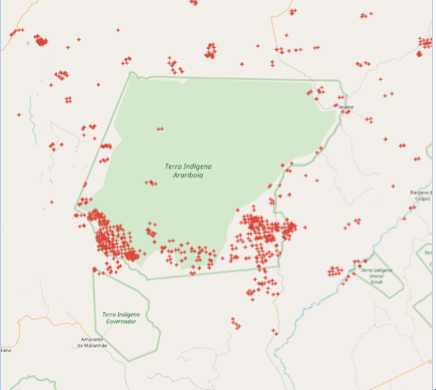By Pires, L. B. M. and Romao, M.
Atlanta, October 20, 2017.
Once again, the Arariboia Indigenous Land located in the southwest of Maranhão, in the Brazilian Amazon, recorded large numbers of outbreaks of fire, putting the population of isolated Indians from the Awá-Guaja ethnic group at risk.
During this year’s season of fires in Maranhão, which runs from August to September, the Arariboia reserve recorded 680 fire outbreaks, according to the MODIS / NASA-AQUA sensor satellite (Figure 1). The outbreaks were concentrated around the Indian reservation, practically surrounding it and creating a complicated situation for the Indians, government agencies and firefighters.
Through the current protocol of interactions established with the Indians of Funai, a Brazilian indigenist agency, contact with isolated Indians is to be completely avoided, so it would not be possible simply to remove them from their reservations due to fire. The alternative was to mount an effective program to combat the fires which involved diverse organs of the federal, state and municipal governments. Much of the success of fighting the outbreaks is due to the 26 Indigenous “Brigadistas” of the Guajajara (Araribóia Indigenous Land) ethnic group, who gave great effort in combating the flames in adverse meteorological conditions including high temperatures, low relative humidity and strong winds, thus avoiding the loss of more lives and forests.
By the end of October the rains are expected to fall again in the region, extinguishing the foci of fire that still persist. However, if more effective control and enforcement is not established in the region, next year we may again see new fires of this magnitude, because activities such as illegal logging and intentional burning to increase the agricultural frontier continue to occur in this part of the Brazilian Amazon.

